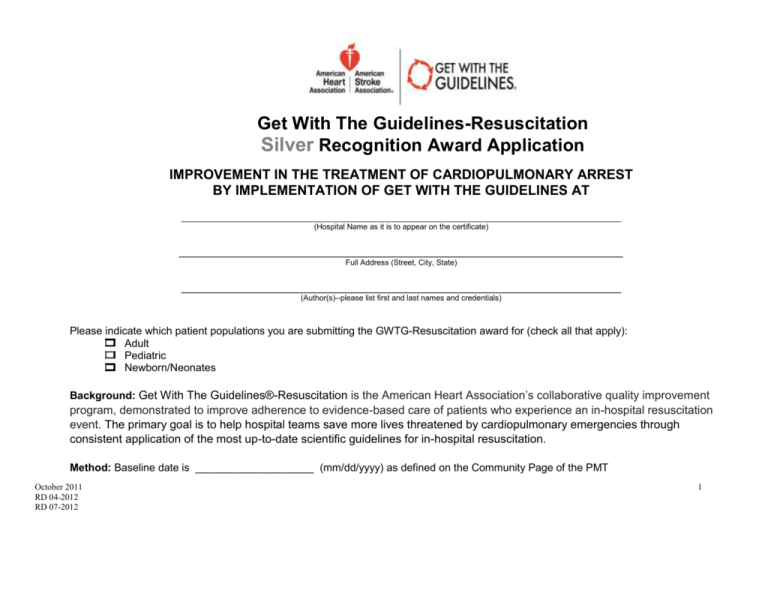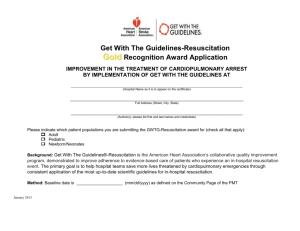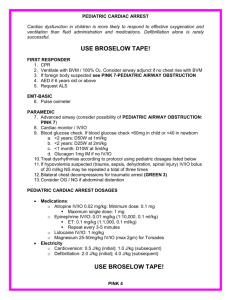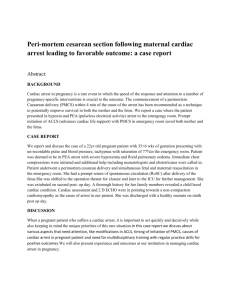Silver - American Heart Association
advertisement

Get With The Guidelines-Resuscitation Silver Recognition Award Application IMPROVEMENT IN THE TREATMENT OF CARDIOPULMONARY ARREST BY IMPLEMENTATION OF GET WITH THE GUIDELINES AT ______________________________________________________________________________________________________ (Hospital Name as it is to appear on the certificate) _______________________________________________________________________________________________________ Full Address (Street, City, State) ______________________________________________________________________________________________________ (Author(s)--please list first and last names and credentials) Please indicate which patient populations you are submitting the GWTG-Resuscitation award for (check all that apply): Adult Pediatric Newborn/Neonates Background: Get With The Guidelines®-Resuscitation is the American Heart Association’s collaborative quality improvement program, demonstrated to improve adherence to evidence-based care of patients who experience an in-hospital resuscitation event. The primary goal is to help hospital teams save more lives threatened by cardiopulmonary emergencies through consistent application of the most up-to-date scientific guidelines for in-hospital resuscitation. Method: Baseline date is ____________________ (mm/dd/yyyy) as defined on the Community Page of the PMT October 2011 RD 04-2012 RD 07-2012 1 Quality Improvement Strategies: 1. What disciplines are represented in your hospitals multidisciplinary Cardiac Arrest team? [Check all that apply for the team that responds to the patient population that is applicable] ___We Do Not Have a Multidisciplinary Team ___Attending or Staff Physician ___ Interns/Residents ___Respiratory Care ___Nurse Manager ___Nurse Supervisor ___Pharmacist ___Critical Care Nurse ___Emergency Room Nurse 2. Is it standard for your hospital to have an identified Code Team Leader for each event? 3. Is Advanced Life Support training required for Cardiac Arrest Team members? Physicians ___Y ___N ___ Unknown Nurses ___Y ___N ___ Unknown 4. Are Cardiac Arrest Team debriefings or reviews routinely conducted? ___Y ___N ___ Unknown 5. Do the members of your multidisciplinary team have FTE Support specifically for QI Activities? 6. Is specific feedback on measure adherence provided to physicians? ___Y ___N ___ Unknown ___Yes as a group ___Yes individually ___No 7. Is there a system in place to provide feedback to the members of the Cardiac Arrest Team? ____Y ____N ______Unknown 8. How often are GWTG reports shared with the Housewide Resuscitation Committee? ___weekly ___monthly ___quarterly ___biannual ___annually ___other 9. What QI processes or interventions were critical to your ability to achieve or sustain this award level of adherence? RD 07-2012 2 Our hospital is entering data (in the PMT): Please check all that apply: ___ Concurrently ___ Retrospectively (after patient is discharged) ___ Via uploads Total number of hospital discharges Please identify number of patients discharged from the hospital for the reporting period Adult mm/dd/yyyy – mm/dd/yyyy Pediatric mm/dd/yyyy – mm/dd/yyyy Newborn/Neonate mm/dd/yyyy – mm/dd/yyyy >number< >number< >number< >number< >number< >number< Number of patients with CPA events entered into the PMT during this post-intervention period. For low volume hospitals, 30 patient minimum per reporting period or the equivalent of 12 months of patients are required. Please identify number of patients for the reporting period. RD 07-2012 3 Results: Implementation of GWTG-Resuscitation showed compliance with the below measures. You must provide the numerator (N) and denominator (D) as well as percentage each measure under the patient populations (Adult, Pediatric and/or Newborn/Neonate) as indicated above. The percentage must be at a minimum of 85% each of the four measures. Percentages may be rounded up to the first decimal (84.6%) as this conforms to PMT percentage reporting. Adult Achievement Measures For All Cardiac Arrest Patients Percent of events in adult patients who were monitored or witnessed at the time of arrest. Percentage of time to first chest compressions <= 1 min in adult patients Percent of adult events with an endotracheal tube placement which was confirmed to be correct. Percent of events in adult patients with VF/pulseless VT as first documented rhythm in whom time to first shock <= 2 minutes of event recognition. Newborn/Neonate Achievement Measures For All Cardiac Arrest Patients Percentage of time to first chest compressions <= 1 min in newborn/neonates >= 10 min old: Percentage of time to first chest compressions <= 2 min for newborn/neonates < 10 min old Percentage of time to invasive airway <= 2 min in newborn/neonates from onset of cardiac event Percent of newborn/neonatal events with an endotracheal tube placement which was confirmed to be correct RD 07-2012 Postintervention N/D (x %) N/D (x %) N/D (x %) N/D (x %) Pediatric Achievement Measures For All Cardiac Arrest Patients Percent of events in pediatric patients who were monitored or witnessed at the time of arrest. Percentage of time to first chest compressions <= 1 min in pediatric patients Percent of pediatric events with an endotracheal tube placement which was confirmed to be correct. Percent of events in pediatric patients with VF/pulseless VT as first documented rhythm in whom time to first shock <= 2 minutes of event recognition. Postintervention N/D (x %) N/D (x %) N/D (x %) N/D (x %) Postintervention N/D (x %) N/D (x %) N/D (x %) N/D (x %) 4








